William Gedney: Early Photographs of the San Francisco Diggers
(October 1966 to January 1967)
Contents:
Note: click on any thumbnail for a full-size version of the image.
Title: Photographs by William Gedney from San Francisco as they
relate to the group The Diggers, including contact sheets, notebook
images, and proofs. Citation:
William Gedney
photographs and papers, 1887, circa 1920, 1940-1998 and undated,
bulk 1955-1989, Collection #RL.10032, David M. Rubenstein Rare Book &
Manuscript Library, Duke University.
If this is your first time visiting the William Gedney archive of
Diggers (etc.) photography, please start with
the original 2002 Introduction, and then come back here for the
"rest of the story" (as Paul Harvey would say).
As the Grateful Dead song "Truckin'" goes, "what a long, strange trip it's
been." What started in 2002 with some faint images on some
fainter contact sheets turned into a quest to bring Bill Gedney's
photographs of the Diggers to life. And here we are twenty years later. Ben Kinmont,
publisher of the Antinomian Press,
who is currently working on a mammoth Free exhibition on the history of
the Diggers, asked
if there was a higher resolution version of the photograph that showed a
group standing around the large milk can ladling out Digger stew. I
hadn't visited the Duke Special Collections web in five years but with
Ben's question in mind I made my way back there. And lo, they have been
busy, printing and scanning hundreds more images from the Gedney archive. Finally
we get to see the faint 35mm images in full detail. In order to showcase
these treasures from Bill's brief hiatus in San Francisco in the waning
days of 1966 and the first weeks of 1967, I have created five separate
galleries (see above Contents links). And,
in the side panel, are a sampling of the
archive, with but a few representative examples. Thank you, William Gedney; your
work lives on.
The following is an overview of the five Gedney galleries that have
been installed recently (August 2022).
Gallery 1: First Digger Feeds (Panhandle); Second Free Store
(Frederick Street)
Description:
These are the photographs that were faintly visible in 2002 with the
first scans that the Duke curators made available of Gedney's contact
sheets from his sojourn in San Francisco in the fall of 1966. Now,
twenty years later, we see (nearly) the whole cast and crew of the first
Digger Free Feeds in the Panhandle and the Free Frame of Reference free
store on Frederick Street. Phyllis, Cindy, Siena, Emmett, Brooks, Kent,
Harvey, Peter (Coyote), John-John, Arthur we now have identified this
cohort but there are undoubtedly many more names that will come to
light. What's missing? The first Free Store on Page Street with its
collection of wooden picture frames; the original "Free Frame of
Reference" that the Diggers used in the Panhandle as a prop in their
Free Theatre; several of the images on the contact sheets that have not
yet been printed (including one with Brooks' VW van that brought the
stew to the feeds).
Description:
In the first book of Gedney's photographs (What
Was True: The Photographs and Notebooks of William Gedney),
there is a curious sequence of a group of young people in the
Haight-Ashbury who appear to be a tribe that the photographer followed
as they moved from one house to another. In addition to the street
scenes that he shot that appear in the book (none of which showed the
Digger feeds) there are indoor scenes showing what appears to be a
communal house. Until the most recent batch of photographs appeared, it
was impossible to know where this was located. However, one of the new
scanned prints clearly shows Phyllis on a floor mattress (as was the
custom in hippie homes). Phyllis confirmed that this was a Digger pad
located on Clayton Street. In fact, it had been the "Antioch house"
where students from Antioch College would live who had been assigned
work-study jobs in San Francisco. Phyllis, and Siena, and Cindy (all of
whom appear in Gedney's photos) were mentioned in the following passage
from Emmett's Ringolevio:
A half-dozen young women [whom Grogan later names as: Natural
Suzanne, Fyllis, Cindy Small, Bobsie, and NanaNina], a few of whom
were dropouts from Antioch College, shared a large pad together on
Clayton Street and volunteered to take over the cooking
indefinitely. (p. 248)
While every instance of a social movement is unique, each occurrence
will inevitably share common aspects that define the contours of the
larger movement they comprise. For example, there were several Digger
pads in the Haight and they shared certain aspects such as the
phenomenon of mattresses directly on the floor. This was an aspect that
probably was common during the Beat period that directly preceded this
time. There are numerous photos from the wire services at the time of
"hippie pads" that all have a certain familiarity. Gedney's photographs
of the Clayton Street Digger pad give us a depth of view that has been
lacking. Another aspect of this phenomenon is being able to compare
these photographs with later collections showing fully developed
communes such as the
Miriam Bobkoff
gallery of photographs of the Scott Street Commune five years after
Gedney's photos.
Gallery 3: Haight Street & Environs
Description:
In John Simon's rollicking tale of adventure (The
Sign of the Fool: Memoirs from the Haight-Ashbury 1965-68), there
are numerous stories that either begin or end at one place on Haight
Street that was a hangout for, among others, the "street Diggers"
Tracy's Donut Shop. And, as luck would have it, Gedney gravitated there
as well. This gallery has dozens of his photographs of the gathering
spot and its denizens. In addition, there are images from Haight Street
and environs, including the "Love Book Bust" at the Psychedelic Shop
(November 15, 1966), and the oddest bit of artistry that predated the
"new bohemians" in the neighborhood Pemabo's Peace Garden. Peter Mason
Bond was well into his 80s when the first inklings of a youth culture
appeared in the Haight-Ashbury but the hand-painted signs that he
planted in his garden on upper Clayton Street certainly were in tune
with the spirit of the time peace, love, and joy.
Gallery 4: Free Fairs, Be-In, Etc.
Description:
We are also fortunate for glimpses of some of the defining moments of
the Sixties Counterculture that Gedney captured in the brief few months
that he spent in San Francisco. Here is a sliver of the events that
became the genetic material of the social movements of the era. The
Artists Liberation Front planned a series of Free Fairs that were
interrupted by the Hunters Point Uprising in San Francisco but William Gedney must have just arrived in San Francisco when the second outdoor
affair took place in the parking lot next to Glide Memorial Church the
weekend of October 8-9, 1966. Gedney captured the wild and joyful
abandon that Barbara Wohl would later describe in the article,
Artists Liberation Front and the
Formation of the Sixties Counterculture. The Free Fairs were
themselves the catalyst for further communal gatherings leading up to
The Human Be-In on January 14, 1967, and Gedney was there, and his
camera captured a rare cross-section of the thousands of people who were
there that day in Golden Gate Park's Polo Field. One of the fascinating
aspects of Gedney's photographs of the first Be-In is the appearance of
many who were in attendance. Among the few who appear to have adopted the
costumes of thrift store imagination are the vast majority who appear in
everyday garb and hair style. Compare this to photographs a few months
later to gauge the speed of adoption of hip couture. Finally, we have a
small set of photographs that Gedney took inside the office of the San
Francisco Oracle, the nation's first psychedelic underground newspaper,
with Allen Cohen and Ron Thelin in front of a collage featuring the
father of the Sixties flower children Allen Ginsberg.
Gallery 5: Notebooks & Writings
Description:
When I first came across the online archive of Gedney's photographs
at Duke University's Special Collections in 2002, there was a separate
file of scanned pages from his numerous notebooks that he kept at hand's
reach. Gedney was an inveterate scribbler, jotting down the infinite
details of his photo shoots, including the numerical order of the Tri-X
or Plus-X film roll, the frame number, and exposure readings he used. In
addition, he would document the location and action of the scene he was
shooting. This is how I determined that he had taken photos of the
Digger Free Feeds within weeks of their startup. In addition, Gedney was
fond of quoting excerpts from books or articles that he had read, or
lyrics from songs he had heard, as well as his own thoughts on issues of
import at the time. These notebooks and writings give us insights into
the man and the artist. Unfortunately, they don't seem to be available
at the Duke archive any longer. This gallery will give any Gedney fan a
much fuller appreciation of the workings of his mind.
William Gale Gedney (1932-89) was a remarkable artist who
never achieved wide recognition during his lifetime. In the past few
years, his work has gained a certain momentum. This resurgence in Gedney
interest has coincided with a major museum exhibition (at the S.F. Museum
of Modern Art in 2000) along with publication of a book of his photographs (What
Was True: The Photographs and Notebooks of William Gedney, edited by
Margaret Sartor) and the major online web archive of his work that was installed
in 1999 at Duke University's Special Collections Library.
Bill Gedney (as his friends called him) was an immersion photographer.
He jumped into and shared the lives of his subjects to a level of
intimacy that few photographers would dare to risk. Bill's most
recognized work stems from journeys he made away from his native
Brooklyn to ever-further locales, documenting through his eyes those
lives he shared if ever so briefly. Kentucky, San Francisco, and India these were the three stops
where he completed some of his most haunting work.
In 1966, Bill received a Guggenheim fellowship to photograph
"American life". Gedney left Brooklyn and drove cross-country to
the West Coast, and ended up in San Francisco in October, 1966. He spent
the next three-plus months in California, taking several thousand
photographs of the people he met and the activities that he observed. As
he did earlier when he traveled to Kentucky (in 1964) Bill lived as close
to his subjects as possible. In Kentucky, he moved in with a coalminer
family. In San Francisco, he moved in with a crash pad family. He followed
this group of approximately six young street people as they moved through
the Haight Ashbury. Through these experiences, Bill was exposed to the
street life as no other photographer did.
In early November, 1966, Bill first came into contact with the Diggers.
(The dating is through his notebooks, of which I will discuss more soon.)
Over the next two months, he photographed the Free Food gatherings on two
different occasions, he photographed the Free Store on Frederick Street on
two different occasions, and he photographed Diggers on Haight Street as
he walked along the street, hanging out with the scene that was coalescing
at this time, prior to the media onslaught that would occur within six
months.
There are several amazing facets about Gedney's work, in my opinion.
First of all, he was a meticulous and devoted scribbler. He kept notebooks
that he used to jot down the date, the subject of the work he was
photographing that day, even to the level of the numbered roll of film and
the F-stop and shutter speed settings he used. The second amazing fact is
that Duke University's Special Collections Library has, in what is most
assuredly a parallel level of meticulousness as Gedney's original work,
scanned many of the pages of his notebooks and made them available on the
web site. Additionally, these archival saints have scanned most of
Gedney's original contact sheets that he used to choose which images to
use for working prints.
Reading through Gedney's notebooks from his 1966 trip is where I
discovered that he had become acquainted with the Diggers. Once I had the
clues that Bill left in his notebook entries, I was able to piece together
the photos in the contact sheets. In all the articles that I have read
about Bill Gedney, I have not seen one mention of the Diggers. It just
goes to show, if you know what you're looking for, you will find gold on
the trail that others have trod many times before.
This then is my hope to be able to present the photographs that Bill Gedney took in November 1966 to January 1967 of the Diggers in the Haight
Ashbury. This is a very special period that Gedney visited in the Digger
chronology. Free Food had barely begun four to six weeks earlier than the
first time Gedney shot their small gathering in the Panhandle. He also
wrote his own reflections on what was happening, and I will copy excerpts
here as well to provide insight to his perspective of this subject.
Eric (2002)
|
Selections (from the galleries)
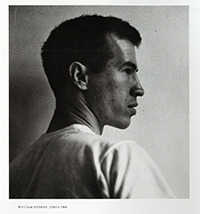
William Gedney, ca. 1960
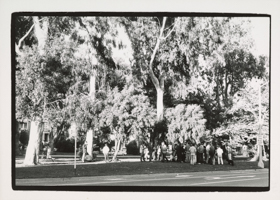
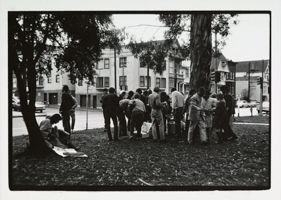
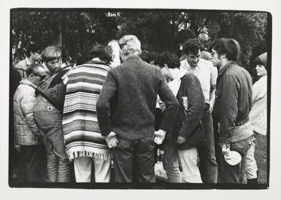
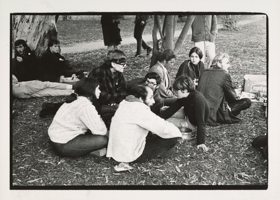
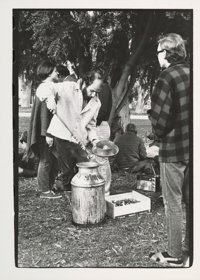
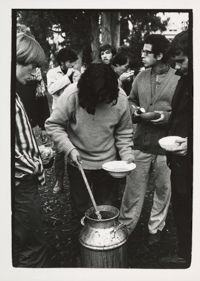
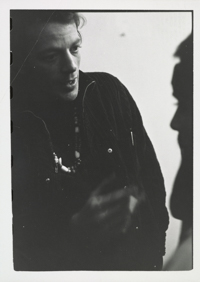
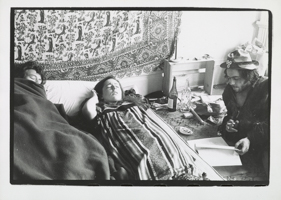
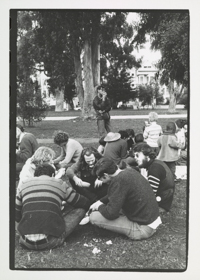
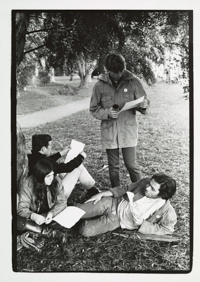
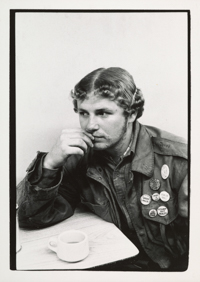
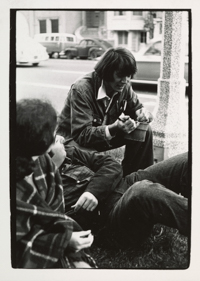
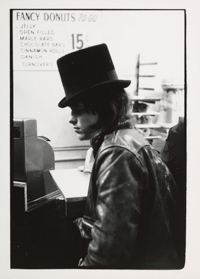
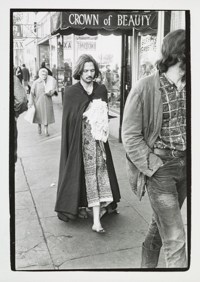
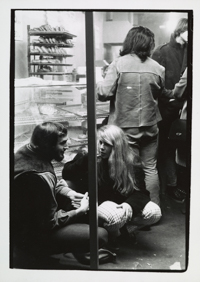
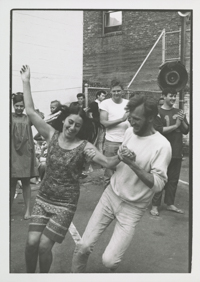
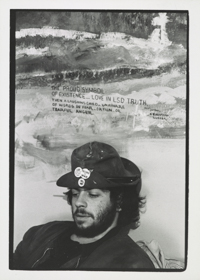
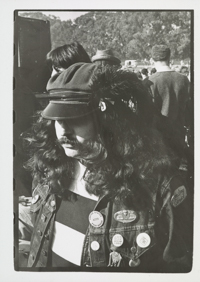

|

